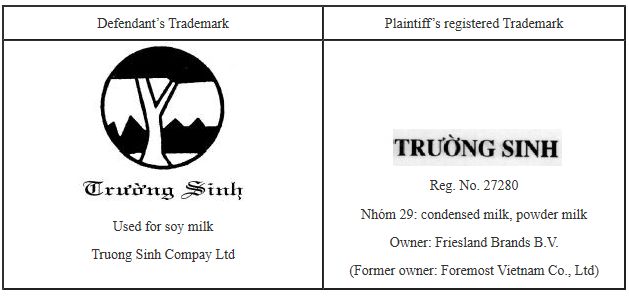Background of the Case
According to the online newspaper VnExpress, on October 23, 2001 the Hanoi civil judgment enforcement agency already organized the destruction of Truong Sinh branded soy milk products after both the first-instance verdict ruled by the Hanoi city's people court and appellate judgment upheld by the Hanoi-based Appellate Court of the Supreme People's Court (also known as the Bench Court) affirmed that the Defendant infringed upon the Plaintiff's exclusive right over the registered trademark Truong Sinh (may be translated as "Longevity") Plaintiff regardless of the fact that the courts' decisions are strongly and widely protested by the Defendant and led to the fact that the Government Office had to request the Ministry of Trade (now as Ministry of Industry and Trade - MoIT) to coordinate with the Ministry of Science, Technology and Environment (now the Ministry of Science and Technology - MoST) to review1

This is a lawsuit that can be considered as a classic one in Vietnam regarding whether or not there is a likelihood of confusion between the Defendant's Truong Sinh branded soy milk products and the Plaitiff's trademark Truong Sinh registered for condensed milk. The history of the case may be found in the Official Letter No. 2275/BTM-QLCL of June 13, 2002 of the MoIT reporting the Government Office, which we briefly describe as follows.:
1 The Plaintiff brought an action against the Defendant before the Hanoi city people's court requesting the court to force the Defendant to cease using the brand Truong Sinh on the latter's soya milk by reason of infringement of the former's registered trademark under registration no. 27 designated for condensed milk along with claim for damages
2 Relied on the expert opinion delivered by the National Office of Industrial Property (now the National Office of Intellectual Property - NOIP) in Dispatch No. 27 of January 13, 2000 in response to the court's inquiry, affirming that the Defendant must terminate the use of trademark Truong Sinh because it constituted an infringement of the Plaintiff's trademark Truong Sinh, the Hanoi People's Court issued the first-instance civil judgment No. 08/DSST dated March 9, 2000 to compel the Defendant terminating the use of such trademark and in the meantime refused any claim for damages
3 Next, on September 18, 2000 the Court of Appeal of the Supreme People's Court in Hanoi, on appeal, handed down an appellate judgment upholding the first instance verdict whereby it forced the Defendant to cease the use of the mark Truong Sinh for soy milk products
4 The Defendant subsequently sended various petitions for rescue addressing relevant agencies and newspapers including the comrades leading the Party, Government, State and National Assembly looking forward to considering and settling this issue.
5 The MoIT was requested by the Government Office in accordance with Official Letter No. 2677/VPCP-VI of June 19, 2001 to coordinate with the MoST to consider and settle the case in accordance with their competence and to report to the Prime Minister. In its official dispatch no. 2403/BKHCNMT-TTr dated August 24, 2001, the MoST reserved its opinion that the Defendant's use of the trademark Truong Sinh has infringed upon the Plaintiff's trademark Truong Sinh.
6 The MoIT contended that the Defendant does not infringe upon the Plaintiff's trademark, nor can it be mistaken between the two trademarks because the products of the parties are different because:
a. For the legal grounds, the MoIT refers to Article 785 of the Civil Code of 1995, where trademarks are signs used to distinguish goods or services of the same kind from different establishments. Trademarks may be words, images or a combination of those elements expressed in one or more colors. Next, the MoIT cites Decree 63/CP of October 24, 1996 guiding the Civil Code on industrial property in Clause 1, Article 15 providing for "scope, content and duration of industrial property rights are identified by the corresponding tittle of protection as granted" and Clause 1, Article 25 stipulates that "the content of protection titles is determined under the decision on granting protection titles, in addition to the information stated in the above-said decision, it must also fully reflect the nature, scope (volume) of protection and other necessary information related to the right to protection".
b. The MoIT believes that the Defendant's condensed milk, powdered milk and Respondent's soy milk are the two different products because: (i) sweetened condensed milk, powdered milk are classified in class 29 while soymilk is grouped in class 32; (ii) According to the classification under the Harmonized Commodity Description and Coding System, or also known as the Harmonized System or the HS2, sweetened condensed milk and powdered milk belong to group 0402/Chapter 4/Part I (animal products) while soymilk is under group 2106/Chapter 21/Part IV; (iii) in terms of origin, properties and uses of products: powdered milk products, sweetened condensed milk and soy milk products are not the same foods, they differ in origin, properties and ingredients. texture, processing, sensory value and nutritional value.
c. Certificate of Trademark Registration No. 27280 protects only "sweetened condensed milk, powdered milk", does not protect soy milk products while the Defendant's product labels are a combination of both figurative and verbal elementsTruong Sinh used for different products, thus they cannot be confused with each other.
d. As provided by the laws, the words "Truong Sinh" (Longevity), "Truong Tho" (Ageless), "Bất lão" (not old), "Trẻ mãi" (Forever young), "Long life" used for food products , or the words "Super-durable", "Eternal" ... with respect to foods cannot be protected as a trademark because they are signs of misleading, confusing or deceiving consumers about the use, quality and value of goods (Point b, Clause 2, Article 6, Decree 63/CP).
e. On the other hand, there is sufficient evidence to substantiate that the Defendant had used the Truong Sinh branded soy milk products before the mark Truong Sinh registered by th Plaintiff; Truong Sinh soy milk has been widely produced and sold regularly since early 1997. In May 1997, the brand "Truong Sinh" was advertised on the Hanoi Television (broadcasted 5 times continuously in May and June 1997).
According to the information stated in the article "Practice of resolving disputes on intellectual property rights in court" by Justice Nguyen Van Tien of the Supreme Court, the Ministry of Health when asked has the opinion that soy milk and sweetened condensed milk are two products with different nutritional quality, but whether or not it violates it at the discretion of the NOIP. The NOIP said that it refused to grant protection of the trademark Truong Sinh for soy milk of the Defendant in 1998. After the Plaintiff accused the Defedant of infringement its trademark, the NOIP has twice sent a written request warning Truong Sinh Company to immediately stop using the "Truong Sinh" trademark for soy milk products. The NOIP also sent Official Letter No. 27 on January 13, 2000 to the court to affirm infringement.
According to Mr. Pham Van Toan, Deputy Chief Inspector of the MoST, the lawsuit has actually been taking place for quite a long time and the Court has had to deal very hard with different opinions of the State agencies, including the contrariwise viewpoints made by the NOIP, MoIT, the Ministry of Health and MoST. Mr. Toan also said that the Court is not capable of making judgments about the infringement, so it depends much on the conclusion of infringement made by other State agencies3.
Comments
The dispute mentioned above occurred too long but in our opinion it can be considered as a classic and worth a reference because:
1 The dispute directly touches on the core nature of the trademark law that is "likehood of confusion", that is, the possibility that consumers may be confused about the origin or source can only happen if there are two factors: (a) trademarks must be identical or similar in terms of structure (composition), connotation (meaning) and pronounciation, and (b) products containing those trademarks must be identical with or similar to each other.
2 The courts including the courts of first instance and the appellate court (under the supreme court) all decided in favor of the Plaintiff based on the professional opinion (expert opinion) of the NOIP affirming that the Truong Sinh used for soy milk is confusingly similar to Truong Sinh used for sweetened condensed milk in the context that the legal documents on this issue are still very primitive, not specific and clear, namely, there is no rule on determination of potential confusion.
3 The expert opinion delivered by the NOIP and the judgments ruled by the courts are correct because soy milk and sweetened condensed milk must be regarded as the same type of goods4 because: (a) soy milk (made from soy) is essentially similar to sweetened condensed milk (made from completely drained cow's milk) and has the same function and purpose because they are both considered nutritious drinks that can be used in replace with sweetened condensed milk (suitable for those who have stomachache due to lactose-free soy milk like sweetened condensed milk), (b) are read and recognized by consumers as "milk" in Vietnmese, and (c) soymilk and sweetened condensed milk are marketed in the same commercial channel (distributed in the same manner, laid next to each other or be sold together). The difference in grouping class 29 or 32 under the Nice Agreement, or the difference between soy milk and sweetened condensed milk in terms of the HS codes as explained by the MoIT is not an appropriate basis to assume that the two products is different because consumers do not know and cannot know soy milk belongs to class 32 for the purpose of distinguishing it with sweetened condensed milk in class 29, as well as they do not care about and cannot know the HS code of the products at the point of choosing and purchasing goods.
4 We opine that the difference in classification according to the Nice Classification is completely meaningless when assessing the "same type" of products, meaning that 2 products can be classified into different classes but in the consumption practice they has the same function of use, the same distribution channel or they are always used together. For instance, toothbrushes with the Nice code 210250 belongs to class 21 while toothpaste (dentifrices) with the code 030079 is classified in class 03.
Footnotes
2 HS stands for Harmonized System. It was developed by the WCO (World Customs Organization) as a multipurpose international product nomenclature that describes the type of good that is shipped. Today, customs officers must use HS code to clear every commodity that enters or crosses any international borders. See more: https://www.tradefinanceglobal.com/freight-forwarding/what-is-an-hs-code/
4 The legal provisions before presence of the 2005 Intellectual Property Law lacked the definition and principles to identify products of the same type. However, factors to consider whether two products are considered as similar kind of products found in Point 21.2 of the NOIP's Trademark Examination Manual of 1991, for example, thereby, for example, two products are considered similar (the same type) if they are nearly identical in nature and have the same function and purpose (for example: noodles - vermicelli, beer – alcohol drink, bricks - tiles, etc.). Soy milk may be found at: https://en.wikipedia.org/wiki/Soy_milk; sweeted condensed milk can be read at: https://en.wikipedia.org/wiki/Condensed_milk
The content of this article is intended to provide a general guide to the subject matter. Specialist advice should be sought about your specific circumstances.

